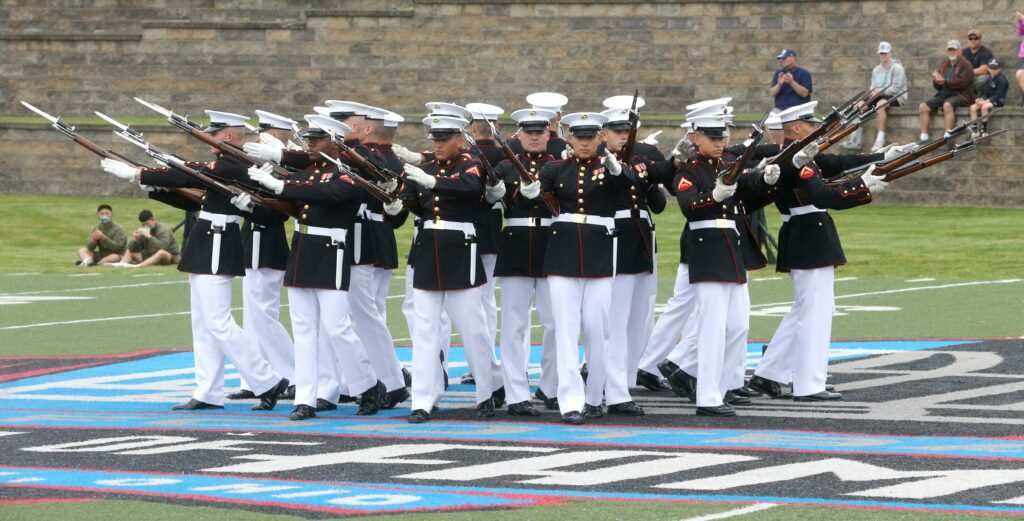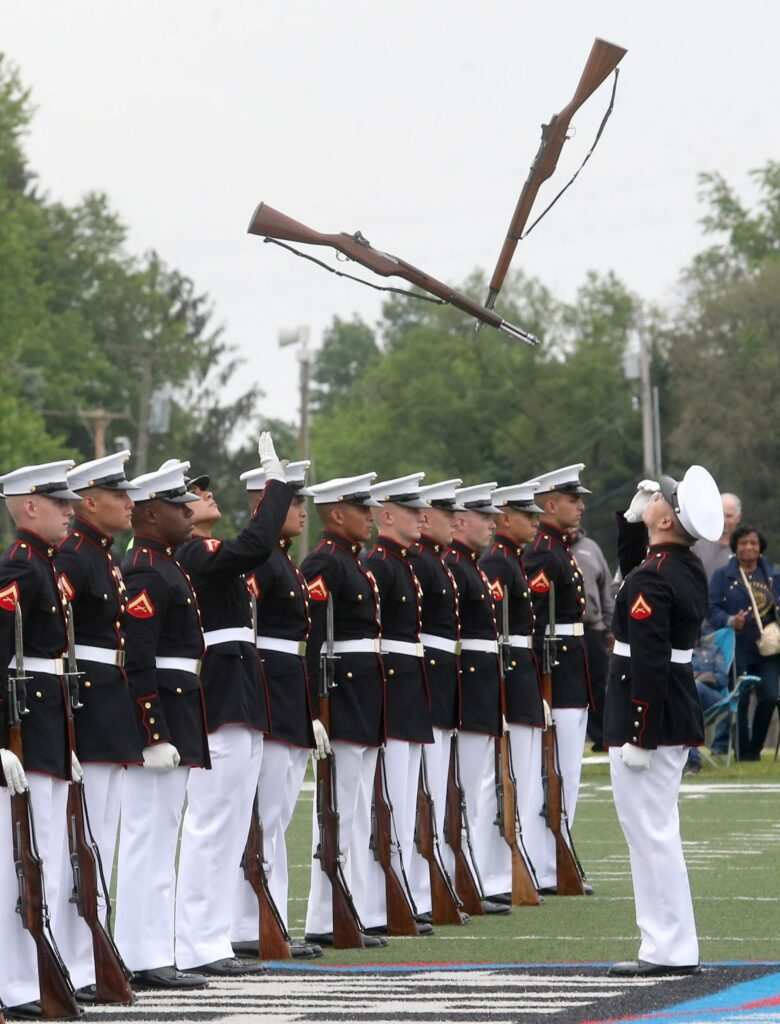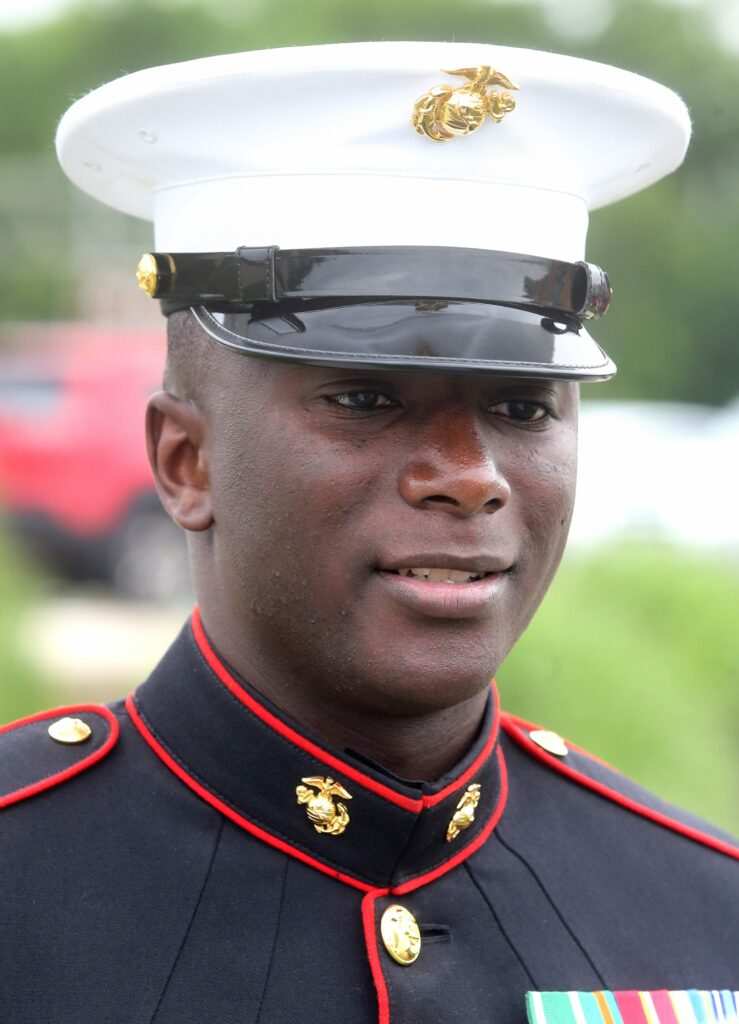The 24 members of the U.S. Marine Corps Silent Drill Platoon seemed to move as one as they marched onto the football field north of the Pro Football Hall of Fame Wednesday afternoon.
Beneath the overcast sky threatening rain, the Marines wore perfectly arranged deep blue tunics, white service caps and stoic expressions as they began twirling their 10.5-pound M1 Garand rifles just inches from their fellow Marines’ ears in tight formations.

Marching with a glide step that barely raised their feet from the field’s turf, the Silent Drill Platoon lived up to its name. Barely a sound could be hear aside from the dull clunking of rifles hitting white-gloved palms, shoulders or the ground.
Many of the more than 200 spectators who came to watch the performance were riveted on the sharp bayonets affixed to the platoon’s rifles. Along with the twirling, the Marines would also quickly turn and thrust their rifles between the ranks behind them, requiring no small amount of precision.

After forming a defensive infantry circle bristling with bayonets, the platoon fanned out to form a long line facing east. From right to left down the line, alternating pairs of Marines spun their rifles like a more solemn, sharper version of a stadium wave.
When the spinning reached the end of the line, Marine after Marine from the right of the line to the left began flipping their rifle and catching it in one hand.
Once that maneuver was completed, one of the platoon’s two rifle inspectors moved down the line, stopping suddenly in front of the tall, thin Marine fifth from the left.

Without a word, the Marine began a series of spins so rapid and elaborate they were hard to follow before tossing the weapon to the rifle inspector who began his own series of flips and twirls.
The first inspection completed, the inspector continued down the line to do two more before the platoon’s commander, Staff Sgt. Henry Truzy marched out.
Wielding a sword that was originally given to the Marine commander at the 1847 Battle of Chapultepec in Mexico, Truzy led the platoon off the field as silently as they had come.

Reaction from those watching the Silent Drill Platoon
The performance, which ran 20 minutes, left Jacob Heidt, who served as a Marine in the Vietnam War from 1969 to 1973, “definitely impressed.”
That is high praise coming from Heidt, a member of an 1812 silent drill platoon that marched to drums after returning from Vietnam in 1972.
Jaylee Straight, 17, and Seth Young, 16, both members of the Navy Junior Reserve Officers Training Corps at Ellet Community Learning Center in Akron, shared Heidt’s amazement.
“Oh, man,” Young said. “There’s a bunch of videos online, but seeing them in person is totally different.”
“It was probably one of the best things I’ve ever seen in my life,” Straight added.
Before the performance, the JROTC members had the opportunity to train hands-on with the members of the Silent Drill Platoon for about a half hour.
Straight and Young said maneuvering the rifles was not as easy as the Marines make it look, but they did manage to master a rifle turn called a diamondback.
Truzy, the commander, said that the Marines train 5 hours a day at the Washington, D.C., barracks and sometimes as long as 17 hours a day when they are training in North Carolina and Arizona after they are selected.
“It’s a lot of memorization,” he said.
Impressive performance at the Hall of Fame
Rich Desrosiers, vice president of communications and public relations at the Hall of Fame, said that the performance was a success.
“The turnout was fantastic,” he said. “I know the Marines were happy to see the field ringed with people.”
Desrosiers added that he is proud of the relationship the Hall of Fame has built with the corps.
The Marines toured the Pro Football Hall of Fame in the morning before training with the JROTC members and the performance. Truzy said even from the brief visit he and his fellow Marines found Canton “pretty nice.”
Truzy said he hopes the performances, 60 across the country since he was selected in January 2020, have a positive impact of the audience because it shows “that no matter what you choose to do in life, you can be excellent.”
___
(c) 2021 The Repository
Distributed by Tribune Content Agency, LLC.



